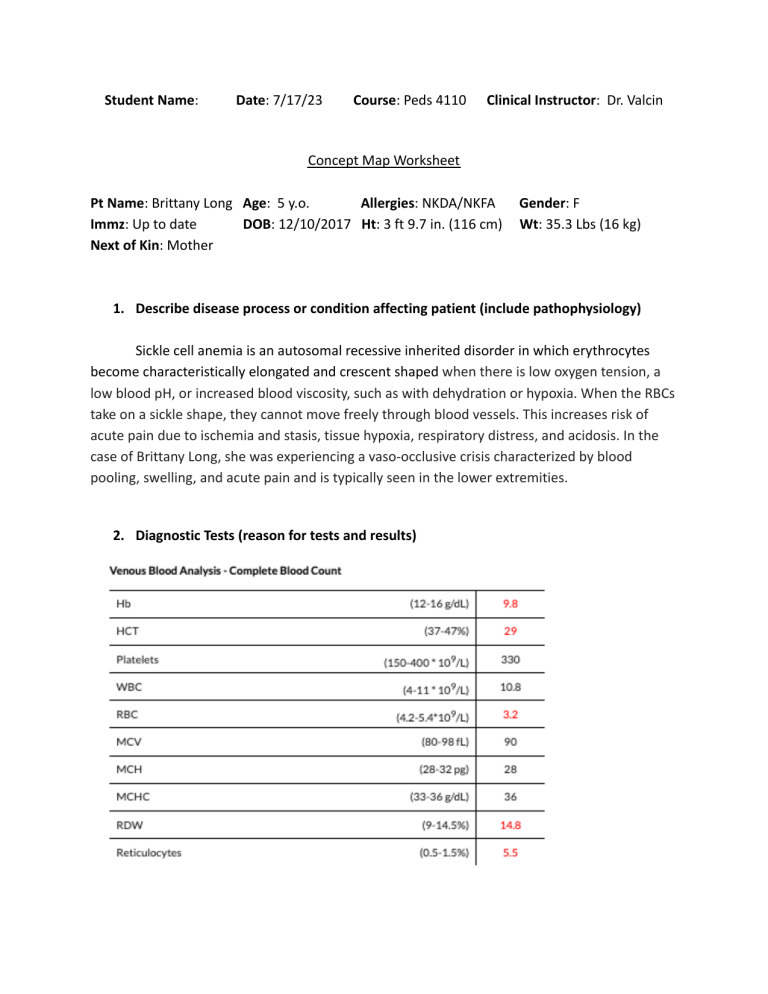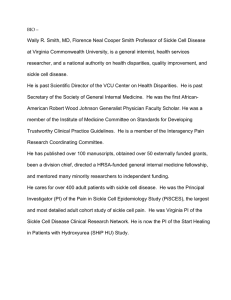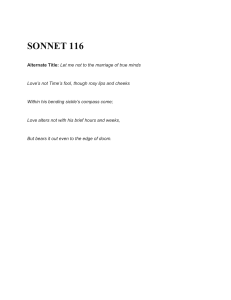
Student Name: Date: 7/17/23 Course: Peds 4110 Clinical Instructor: Dr. Valcin Concept Map Worksheet Pt Name: Brittany Long Age: 5 y.o. Allergies: NKDA/NKFA Immz: Up to date DOB: 12/10/2017 Ht: 3 ft 9.7 in. (116 cm) Next of Kin: Mother Gender: F Wt: 35.3 Lbs (16 kg) 1. Describe disease process or condition affecting patient (include pathophysiology) Sickle cell anemia is an autosomal recessive inherited disorder in which erythrocytes become characteristically elongated and crescent shaped when there is low oxygen tension, a low blood pH, or increased blood viscosity, such as with dehydration or hypoxia. When the RBCs take on a sickle shape, they cannot move freely through blood vessels. This increases risk of acute pain due to ischemia and stasis, tissue hypoxia, respiratory distress, and acidosis. In the case of Brittany Long, she was experiencing a vaso-occlusive crisis characterized by blood pooling, swelling, and acute pain and is typically seen in the lower extremities. 2. Diagnostic Tests (reason for tests and results) 3. Anticipated physical findings ● ● ● ● Pain Pallor (paleness of skin and mucous membranes) Lower than average growth and development Swelling of hands and feet (hand-foot syndrome) 4. Anticipated nursing interventions ● Pain management through both pharmaceutical and comfort measures ● Hydration through IV fluids ● Infection prevention ● Oxygen therapy ● Monitor intake and output ● Frequent vitals Student Name: Date: 7/17/23 Course: Peds 4110 Clinical Instructor: Dr. Valcin INTRODUCTION Your name, position (RN), unit you are working on Hi, my name is ( ). I am a nurse in the pediatric unit. SITUATION Brittany Long is a 5 year old female who was admitted due to Patient’s name, age, specific reason for visit Sickle cell anemia. BACKGROUND Patient’s primary diagnosis, date of admission, current orders for patient ASSESSMENT Current pertinent assessment data using head to toe approach, pertinent diagnostics, vital signs RECOMMENDATION Any orders or recommendations you may have for this patient Brittany Long has a history of sickle cell disease, diagnosed at 6 months old, and has been prescribed a regular folic acid supplement. The parent stated the patient had been complaining of right lower leg pain over the last 2 days. She has not had an appetite in the last 24 hours but is taking small amounts of oral fluids. She has had pain crises before, mostly managed at home with acetaminophen and ibuprofen. She has been hospitalized twice, once at age 4 years for a vaso-occlusive crisis episode and once at age 3 years for a fever. She was admitted through the ED last night. Brittany is having pain in her right leg that is exacerbated with movement or touch. Temperature, circulation, and pulses in the legs are equal bilaterally. Heart and bowel sounds were normal, and lungs were clear to auscultation. Upon initial assessment, the patient was rating her pain a 6/10, HR was 128, and BP was 110/68. Patient and family requested medication for pain relief. Per provider orders, the patient was given 1.6 mg of morphine IVP and a 250-mL fluid bolus of 0.9% sodium chloride with a maintenance infusion of 5% dextrose and 0.45% sodium chloride infusing at 52 mL/hr. Vital signs following morphine and fluid bolus are heart rate 110, respiratory rate 26, blood pressure 100/60, temperature 99.3°(37.4°C), and SpO2 97%, and her pain rating is now 2/10. The family of the patient demonstrated a good understanding of the importance of hydration, ambulation, and management of sickle cell disease in general. Continue to monitor patient pain level and offer additional nonpharmacological methods of support for pain management. Continue with monitoring hydration status and ensure the patient maintains regular ambulation and breathing exercises. Student Name: Date: 7/17/23 Course: Peds 4110 Clinical Instructor: Dr. Valcin PATIENT EDUCATION WORKSHEET NAME OF MEDICATION, CLASSIFICATION, AND INCLUDE PROTOTYPE Morphine sulfate Opioid analgesic SAFE DOSE OR DOSE RANGE, SAFE ROUTE Brittany Long was prescribed: 1.6mg (0.1mg/kg/dose) IV q3h Children >1 month: 0.02-2.6mg/kg/hr continuous infusion for sickle cell or cancer pain PURPOSE FOR TAKING THIS MEDICATION Used for severe pain. Works by binding to opiate receptors in the CNS. Alters the perception of pain, generalized CNS depression. PATIENT EDUCATION WHILE TAKING THIS MEDICATION Common side effects include hypotension, constipation, confusion, and sedation. Use with caution with other CNS depressants, can cause profound sedation, leading to coma and possibly death. Initials: BL Diagnosis: Sickle cell Age: 5 y.o Allergies: NKDA/KNFA Student Name: Date: 7/17/23 HCP: n/a Isolation: standard IV Type: isotonic Consults: n/a Fall Risk: increased Location: R ac Transfer: n/a Course: Peds 4110 Clinical Instructor: Dr. Valcin Fluid/Rate: 250 mL 0.9 NaCl IV over 30 min M/F: F Critical Labs: Creat Cl Hct Hb RBC RDW Other Services: n/a Consults Needed: n/a Length of stay: n/a Code Status: Full code Why is your patient in the hospital (Answer in your own words and include the History of present illness)?: Brittany Long was admitted to the ED last night for pain in her right leg. She has PMHX sickle cell disease, taking regular folic acid supplements. The parent reported she had been complaining of right lower leg pain over the last 2 days. She has not had an appetite in the last 24 hours but is taking small amounts of oral fluids. She has had pain crises before, mostly managed at home with acetaminophen and ibuprofen. She has been hospitalized twice, once at age 4 years for a vaso-occlusive crisis episode and once at age 3 years for a fever. Health History/Comorbidities (that relate to this hospitalization): ● Sickle cell disease ● Hx of vaso-occlusive crisis (4 yrs ago) Shift Goals/Patient Education: The patient's pain will be appropriately managed. The patient will not experience a vaso-occlusive crisis. Path to Discharge: Monitor and treat pt’s pain, perform patient and relative education. Path to Death or Injury: vaso-occlusive crisis, ACS, stroke, infection, organ damage, pain crisis, medication errors, fluid/electrolyte overload Management of Care Alerts 1. Changes in O2 sat: can indicate vaso-occlusive crisis or ACS. 2. Signs of pain: patients with sickle cell are typically in a lot of pain. 3. Fluid status: dehydration can trigger a crisis. 1. Taking vital signs and looking for an abnormalities 2. Assessing pt’s pain using FACES scale 3. Administer ordered medications 4. Patient and relative education Assessments Priorities for Management 1. 2. 3. 4. Medical history Labs: CBC and HGB Pain levels Vitals/O2 sat Complications 1. Promptly assess and manage pain using appropriate analgesics and interventions. 2. Monitor for respiratory symptoms, obtain a chest X-ray if necessary, and initiate appropriate interventions, including oxygen therapy and antibiotics. 3. Be vigilant for signs of infection, including fever, chills, rapid breathing, and localized symptoms. Promptly evaluate and initiate appropriate antibiotic therapy. 4. Urgently evaluate and consider interventions to prevent or treat stroke, including blood transfusion therapy. 1. Pain Crisis: sudden, severe pain is a hallmark of sickle cell disease. 2. Acute Chest Syndrome: a serious complication characterized by chest pain, fever, cough, and difficulty breathing. 3. Infections: sickle cell disease increases the risk of bacterial Delegation infections, particularly pneumonia and meningitis. 1. Taking vitals and helping to feed the patient can be delegated 4. Stroke: sickle cell disease can predispose to strokes, to the PCA. especially in children. Interventions 1. Check Iv site for an redness, swelling or signs of infiltration 2. Ensure proper fluid intake and encourage oral fluids





